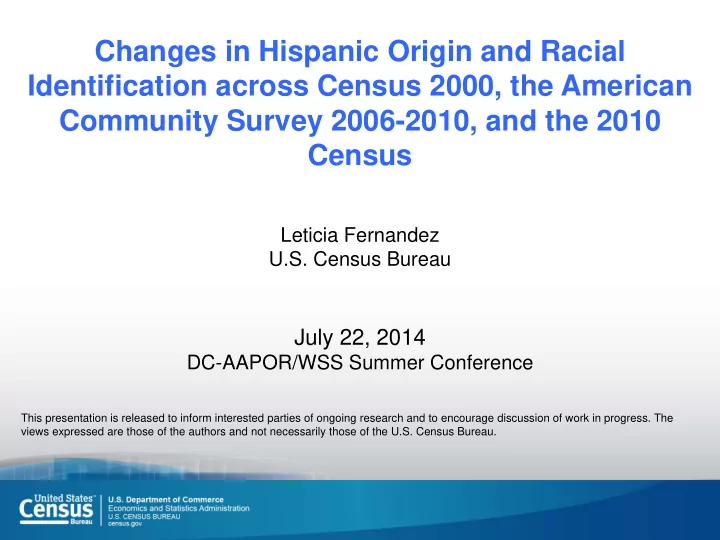

Changes in Hispanic Origin and Racial Identification across Census 2000, the American Community Survey 2006-2010, and the 2010 Census Leticia Fernandez U.S. Census Bureau July 22, 2014 DC-AAPOR/WSS Summer Conference This presentation is released to inform interested parties of ongoing research and to encourage discussion of work in progress. The views expressed are those of the authors and not necessarily those of the U.S. Census Bureau.
Motivation The 2010 Hispanic population in the United States was estimated at 50.5 million, representing an increase of 43 percent since Census 2000 enumeration. In addition to demographic factors, the changes in the size of the Hispanic population could have been influenced by questionnaire changes and fluidity in Hispanic reporting. Hispanic reporting is sensitive to question wording and format (e.g., order of Hispanic origin and race question or combined versus separate formats may elicit different responses). Some Hispanics may view their ethnicity as fluid or flexible and may change identification over time or depending on context (e.g., home versus at school). Through intermarriage and socioeconomic assimilation, U.S.-born individuals of Hispanic ancestry may become less and less likely to identify as Hispanic. 2
Changes in Hispanic Origin and Race Instructions and Question Wording ACS 2008-2010 & 2010 Census Census 2000 & ACS 2006-2007 3
Objectives Examine the demographic and socioeconomic factors associated with individuals who… (a) consistently identify as Hispanic; (b) consistently identify as non-Hispanic (of Hispanic ancestry); (c) change between Hispanic and non-Hispanic when answering the same question, and (d) change between Hispanic and non-Hispanic when answering questions worded differently. Can we identify differences in reporting of Hispanic origin associated with changes in question wording? Does consistency in reporting as Hispanic vary by race? 4
Data Linked data across Census 2000, 2010 Census, and the 5-year American Community Survey (ACS) 2006-2010. Use of probability record linkage techniques to assign a unique Protected Identification Key (PIK). Personally identifiable information (name, date of birth, address, etc.) is removed to anonymize the data and preserve confidentiality. Sample limited to PIKed individuals who could be linked across Census and ACS. Not representative of the Hispanic population in the U.S. Unclear whether the same or another household member answered the questions Ever reporting as Hispanic or of Hispanic ancestry Age 25 and older in ACS Unweighted sample size 645,649; ACS-weighted sample size 12,228,700 5
6
Independent Variables in the Analysis of Hispanic Origin Identification Demographic Characteristics Age, gender, marital status, Hispanic origin, ancestry, race response consistency between the first and the second interviews Socio-Economic Characteristics Education, adjusted personal income (log) Assimilation Measures Nativity/years in the US, naturalization, English language proficiency Contextual Factors Region of residence, and whether person changed region between reports; percent Hispanic in tract of residence and change in percent Hispanic between reports. Data collection Mode Mail-out mail-back vs all other mode combinations 7
1. Changes in Hispanic Identification between Census 2000 and 2010 Census (Different Question Wording) Individuals with some college and those with a college degree were more likely to switch from non-Hispanic to Hispanic than those with a high school education. Individuals with backgrounds from Central America, South America, Dominican Republic and Cuba were more likely to change their response from non-Hispanic to Hispanic than those with backgrounds from Mexico and Puerto Rico. 8
2. Changes in Hispanic Identification Regardless of Differences in Question Wording Several factors associated with higher odds of changing Hispanic identification, regardless of differences in Hispanic origin question wording: Ancestry - Mixed ancestry listing Hispanic last or not at all Assimilation indicators – Native and English monolingual individuals Mode of data collection – Modes that were not “mail -out mail- back” in both years Race – Black alone, Asian/NHPI alone, and those reporting the same race in both years 9
Changes in Race Response by Hispanic Identification, Different Question Wording 1 2 3 4 Source: Census 2000, 2010 Census and 2006-2010 ACS 5-year data. 10
What Race Do “Always - Hispanic” Change To? Race reported in 2010 Race reported in 2000 Source: Census 2000, 2010 Census and 2006-2010 ACS 5-year data. 11
Preliminary Conclusions and Next Steps Changes in Hispanic origin identification take place in a relatively small percent of the Hispanic population, regardless of question wording. Natives, English monolinguals, some race groups, some Hispanic origins and mixed ancestry more likely to change. Changes in question wording may have increased Hispanic reporting among more educated individuals. The dynamic relationship between race and Hispanic origin had not been identified before. Need to understand its context and drivers. 12
Thank You! leticia.esther.fernandez@census.gov sonya.rastogi@census.gov renuka.bhaskar@census.gov 13
Recommend
More recommend